
CME: Clinical Disorders of the Aging Spine
 |
Edward P Abraham, MD, FRCSC, Associate Professor of Surgery, Department of Orthopaedics, Dalhousie University Medical School, Saint John Campus, Saint John NB Canada Canada East Spine Centre, Horizon Health Network. |
 |
Hamilton Hall, MD, FRCSC, Professor, Department of Surgery, University of Toronto, Executive Director, Canadian Spine Society, Toronto, ON. |
 |
This learning program has been developed for primary care physicians, educators, and other health care professionals.
|
 |
At the completion of this learning module, the participants should be able to:
|
 |
This eLearning module fits within the Mainpro+ Self-Learning Activities Section. You may submit this non-certified* activity for one non-certified credit per hour. At the end of the presentation you may also download the Certificate of Participation as a confirmation of you taking part in this activity. *Non-certified activities have not been formally reviewed by the College but comply with the College’s definition of CPD, are non-promotional in nature, and provide valuable professional learning opportunities. |
 |
Views and opinions in this program are of the faculty and not necessarily endorsed by, or reflective of, those of the publisher or editors of Health Plexus. The development of this CME program was supported by an unrestricted educational grant from Medtronic Canada Ltd. |
Section:
